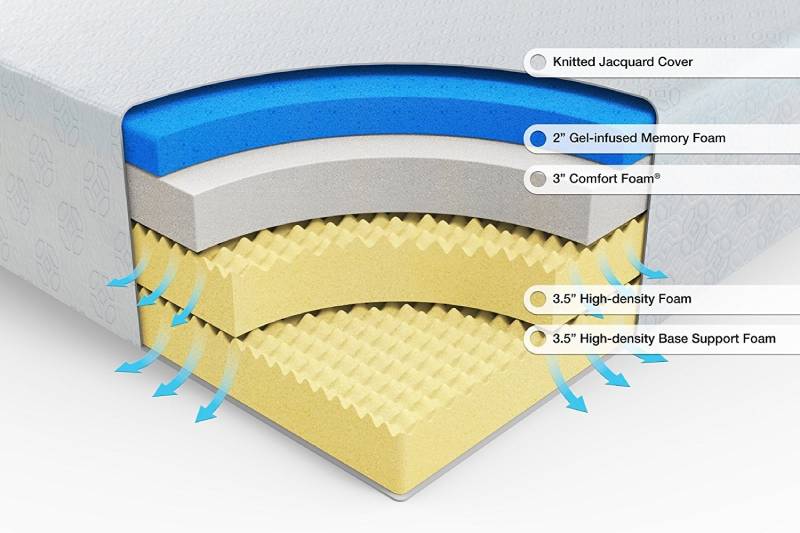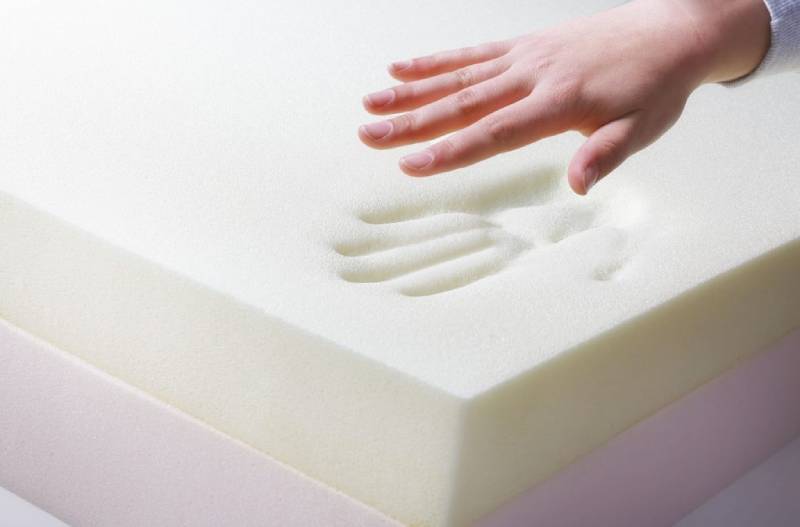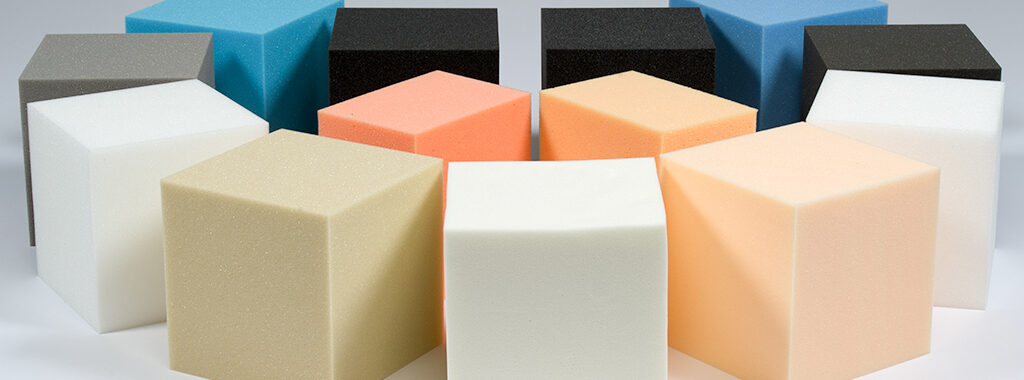When buying a memory foam mattress, one of the most important qualities to consider is its density. This plays a significant role in determining its caliber, durability, and comfort. If the density is not appropriate, it will affect your sleep as well as health.
Many buyers fail to understand the concept of density and end up buying a mattress that is neither comfortable nor durable. So, how do you make the right decision?
This post discusses the concept of density, why it’s important and how to choose the right memory foam mattress.
Memory Foam Mattress Density: How to Choose the Perfect Level
Memory foam mattresses are constructed using layers of foam, and each layer is usually of a different density. To understand the best density of the foam and find a comfortable mattress, keep reading.

Also read: How much does memory foam cost?
What Is Foam Density?
The density of memory foam determines the firmness of the mattress. Expressed in pounds per cubic foot (lbs/ft3), this measurement indicates how compressed the material is into a specific amount of space.
For instance, if the foam density of a mattress is five pounds per cubic foot, this means that every cubic foot of foam weigh five pounds.
Denser foams mean more material is used to make the mattress and it will provide greater support person sleeping comfortably on a bed.
Which One to Choose
Broadly speaking, memory foam mattresses come in three densities: low, medium, and high. Let us discuss them in detail.
Low Density
Memory foam with a density of 3 lbs/ft3 or lower is low-density. It feels softer than other mattresses and allows you to sink into it. This density is ideal for people who want a soft bed at an affordable price as less foam is used than other mattress types. If you’re on a tight budget, you may want to opt for a low-density foam mattress, but sinking into it too much can affect your sleeping posture.
Medium Density
Medium-density memory foam has a measurement of 4 to 5 lbs/ft3. It offers a perfect combination of comfort, durability, and support at reasonable prices. These mattresses allow you to sink without much resistance, thus offering comfort and back support. Consider a medium density memory foam mattress if you’re a first-time buyer as it’s a good option for an average sleeper
High Density
High-density memory foam measures 6 lbs/ft3 or more. These kinds of mattresses are the most common in the market as they offer excellent durability and support. They are a little more expensive than other mattresses but provide firmer base foam for greater comfort.
They also offer stiff back support and mold to your body to relieve pressure joints. If you suffer from backache and want to improve your blood circulation, high-density memory foam mattresses are your best bet.

QUICK FACT
Also known as temper foam, memory foam was developed in the 1970s under a NASA contract that set out to improve seat cushioning and crash protection for airline pilots and passengers.
High density foam: Why Is Density foam Important?
Density is an integral quality of memory foam mattresses because it can impact several characteristics apart from firmness, including price, lifespan, off-gassing, stability, and relief from ache.
If you buy a foam mattress with a high density, it will cost more, last longer, provide more uniform support and conform more strongly to your body. This will reduce the chance of back and neck pain.
However, higher density mattresses are not suitable where off-gassing is concerned. This is because the higher the mattress density, the more time it takes for the chemical odor or gas to clear. This can lead to allergic reactions and respiratory issues.
By contrast, low-density mattresses stop releasing chemical odors comparatively faster. Unfortunately, off-gassing is harmful to health, irrespective of mattress density. That’s why many homeowners prefer organic mattresses made of 100% natural latex or cotton.
High density foam:Do you want to know more about memory foam mattresses?
Maybe getting answers to some frequently asked questions will help you make an informed decision.
FAQs on Memory Foam Mattresses
Does the density of a memory foam mattress affect motion isolation?
No. In fact, all memory foam mattresses offer high motion isolation.
Motion isolation is the measurement of how much one sleeper’s movement can be felt by their bed partner. This is a common concern of people who have trouble sleeping next to their partner.
The good news is that all types of memory foam mattresses are great when it comes to motion isolation, no matter their density.
Is density the same thing as firmness?
No. Density and firmness are not the same.
Density is the weight per unit of volume and affects several aspects of a mattress such as its durability, odor potential and cost. By contrast, firmness refers to how soft or firm the mattress feels.
Does a memory foam mattress’s density affect heat retention?
Yes. The density of the top layer can impact its heat retention.
If the top layer of the mattress is low density, your body will sink further into the mattress, thus making you feel warmer because your body heat will build up around you.
A higher density foam mattress will offer firmer support, thus keeping you on top and allowing more air to circulate around you. So, if you want to sleep in a cooler environment, choose a high-density foam mattress.
What is the ideal density for side sleepers?
Low-density memory foam mattresses work best for side sleepers.
Side sleepers should choose low-density memory foam mattresses as there are a significant number of curves on the side of your body like shoulders, hips, and knees.
That is why they need a soft surface, to give the support they require while gently cradling hips and shoulders to prevent stress and injury.
Consider density before buying a memory foam mattress. This plays a vital role in determining the level of support and comfort you get while sleeping.
If you are not sure about the density, then buy an organic mattress made of all-natural ingredients that allow you to sleep comfortably without worrying about off-gassing.
High Density Foam Mattress are some of the most popular mattresses out there. Mattress density is an important factor to consider when selecting a mattress. Density dictates a foam’s quality, comfort, and longevity. That is why the higher the foam density, the better the quality.
One would be forgiven, however, for thinking that density equates to a mattresses’ firmness or feel. The truth is density is a different measurement from firmness. Density, in short, is the weight of the mattress per cubic foot, while firmness is measured by indentation load deflection (IDL), something we will touch on later in this article.
If you don’t really know what density has to do with mattresses or it’s importance. Worry not, you are not alone, most people do not know either and that is why we aim to explain what a high-density foam mattress is and its benefits in this article.
What is a high-density foam mattress?
To answer what a high-density foam mattress is, we must first understand what density is. Density is mass per volume.
It is calculated by dividing mass and volume. In simple, density is the amount of weight contained per cubic foot of an object.
The more weight contained per cubic foot, the higher the density. This makes higher density foams more compact, increasing their quality and durability tremendously.
How is foam density measured?
Density is usually measured in pounds per cubic foot (lbs/ft3) or (PCF). One cubic foot is measured by multiplying a foot of Length*Height*Width (12 inches by 12 inches by 12 inches).

High density foam: Difference between density and firmness:
Most people tend to think that the higher the density, the firmer a mattress is. But that is not entirely true. Firmness which relates to how a mattress feels is measured by Indentation Load deflection (ILD) or Indentation Force Deflection (IFD).
The higher the ILD, the firmer a mattress will feel. Usually, anything less than 19 ILD is considered plush while anything around 50ILD is considered firm.
Indentation Load Deflection is directly proportional to thickness, the thicker the foam is, the higher the ILD. Thus, thickness determines the firmness of a mattress. Whereas density is just a measurement of the weight per cubic foot of the mattress.
Knowing the density of a mattress matter a lot. The higher the density, the more durable and supportive a mattress will be.
Foam density measurements:
Both flexible and viscoelastic polyurethane foams are categorized into three density levels. That is low, medium, and high. To understand the
Generally, a heavier foam will have a higher density. For example, a 100-pound foam measuring 25lb/ft3 will have a density of 4lbs. While a 50-pound foam measuring 25lb/ft3 will have a density of 2lbs.
High density foam: How to tell whether you need a high foam density mattress or not?
Now that you know what a density foam mattress is, let’s look at some aspects of a High-Density Mattress. These aspects will help you decide whether this is the right foam density for you or not.
Also read: How do you make foam?

1-
High density foam, Durability:
Higher-density foams last longer than their counterparts because of their compact nature. Buying a mattress is a considerable investment. You want to buy something that lasts. Now that we have determined that density is directly associated with the quality and longevity of a foam mattress. The higher the density, the more durable the mattress will be.
The additional material contained per cubic foot of a dense foam mattress slows down its wear and tear. This makes high-density foams more durable than lower density foams.
2- Motion isolation:
The higher the density of a foam mattress, the stronger the motion isolation.
Foam mattress rate highly when it comes to motion isolation. Their ability to contour to our bodies creates a cradling effect that absorbs other movements.
People who tend to toss and turn a lot in bed benefit greatly from a higher density foam. Many people who share a bed with a partner who moves a lot reported great motion isolation after using a high-density foam mattress.
3- Support:
High density-foams are almost always used as cores of foam mattresses. This is because they offer superior support than their counterparts.
The higher the density of a mattress the more support you get. This, however, is controlled by the weight of the person lying on the mattress.
Heavier people will benefit most from a high-density foam mattress than lighter people.
4- Pain pressure relief:
Higher-density foams are especially good for pain and pressure relief. If you suffer back pains, then investing in a denser foam mattress could save you sleepless nights.
Since they are more compact than lower density foams, they don’t sink in too much, allowing proper alignment of head, shoulders, and hips for better spine health.
Higher-density foams are especially good for back and stomach sleepers. The fact that they do not sag quickly means, they offer great back and neck support.

5 -Conforming:
The denser the foam structure, the better the contouring. However, body types also dictate the type of foam density.
Higher densities are great for heavier bodies of at least 230lbs or more. While medium density is recommended for people who weigh 130-230lbs.
When heavier people sleep on lower density foams, they experience a lot of sinking that causes misalignment and discomfort while sleeping.
Lighter people, who weigh less than 130lbs find higher density foams uncomfortable. This is because they don’t get proper contouring and the mattress feels too firm for them. In such instances, low to medium density foams are recommended.
6- Temperature Neutrality:
Foam mattresses are known to sleep hot. This gets worse as the density increases. Higher-density foams have less air space. This restricts airflow and aids the mattress in trapping heat. Causing this type of foam to sleep hotter than other lighter foams.
7 – Off-gassing:
Foam mattresses are notorious for off-gassing. Off-gassing is a reaction caused by the breaking down of Volatile Organic compounds (VOC’s).
In the mattress world, the denser the foam the more off-gassing is experienced.
In such situations, the only solution is to air the mattress and patiently wait it out. A denser foam mattress will take longer to lose the odor. If you are affected by strong chemical odors, you might want to go with a lighter density foam.
8- Prices:
As mentioned before, higher density foams offer more quality and are more durable. As such, they tend to be costlier than other foam densities.
Average coast of high-density foam ranges from $1000-$1400, while other densities range from $500-$950.
9 – Movement:
A high-density foam tends to be the heaviest type of foam. This means it is not easily movable. As such, you should consider for which purpose you are purchasing a higher density mattress.
Our Costumers Loves Us
Ready to buy foam? PleasE Order now.
If you need more information, Please contact us.





